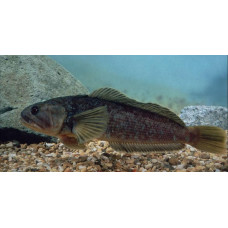Nototheniidae is a family of fishes of the order Perciformes. 15 genera, more than 50 species (gray, marbled, narrow-bodied nototheniidae, Antarctic toothfish, etc.) Length up to 2 m. Marine, benthic fishes. They inhabit Antarctic and sub-Antarctic waters. The body is covered with fine scales. Lateral lines one or two or three, more often two: one located on the tail stalk, and the other along the body. Pelvic fins in front of the pectoral fins. Lay bottom eggs. Feed on krill and fish. The best known Notothenia rossi, reaching a length of 90 cm. Many Nototheniidae are targeted by fisheries.
Representatives of the family, mainly bottom and benthic fishes, in general have a rather wide range and are distributed mainly in high-latitude Antarctica near the shores of Antarctica and near the northern boundary of the Southern Ocean - in the thalassobathiale of subantarctic islands.
The Nototheniidae, like other representatives of the suborder Notothenioidei, descended from typical bottom fishes, lack a swim bladder; nevertheless, some species of the family in the process of evolution have successfully mastered the pelagial zone, turning into secondary-pelagic and cryopelagic (associated with floating ice) fishes. Pelagization in the family was carried out both due to changes in the general morphology of the body and due to a decrease in the specific weight of fish by watering of muscles, formation of peculiar intramuscular fat depots - lipid sacs, as well as a decrease in bone mineralization and reduction of bony elements of the skeleton, as a result of which the buoyancy of the body approached neutral. The majority of typical Antarctic species living at water temperatures close to freezing (up to minus 1.9 degrees Celsius) have in blood and other body fluids peculiar biological antifreezes, special compounds of sugars with proteins - glycoproteins, preventing the formation or critical growth of ice crystals in the body. Another important adaptation to the way of life at constant subzero temperatures is the decrease in the number of form elements in the blood, primarily red blood cells, which contributes to a significant decrease in blood viscosity and, accordingly, its faster circulation in the circulatory system.
Body of Nototheniidae elongated, compressed from sides, usually covered with ctenoid scales, sometimes with cycloid scales. The mouth is terminal, with a horizontal or oblique oral slit; the upper jaw is weakly erect. Teeth on jaws small bristle-shaped, conical or fang-like; no teeth on palatine bone and scutellum. Gill membranes are usually added to the isthmus and form a short fold; in some fishes, the gill membrane is not added to the isthmus. Usually two separate dorsal fins: in the first dorsal fin usually 3-11 flexible (sometimes rigid) barbs, in the second dorsal fin 25-42 articulate rays. The anal fin has 22-40 segmented rays. Most of the rays in the second dorsal and anal fins are branching. The pectoral fin is large, fan-shaped, contains 16-33 rays, mostly branched, except for the uppermost unbranched ray. The pelvic fin is southerly, contains 1 barbed and 5 articulate rays. Caudal fin rounded or notched, contains 10-17 branched rays. Gill membrane rays are 6, occasionally 5 or 7. One tubular nostril on each side.
Clypeal and pre-clypeal bones without spines, except for Trematomus scotti, which has a blunt spine on the clypeal bone. Lateral lines are usually 1-3 (dorsal, medial and anal), represented by tubular and punctate scales (Gvozdarus svetovidovi has 4 lateral lines, including supradorsal). Gill stamens well developed. Vertebrae 45-59.
Nototheniidae
Tags: nototheniidae




